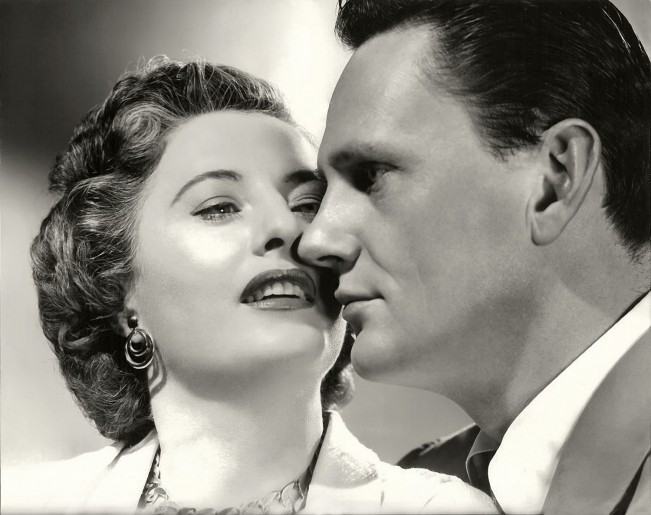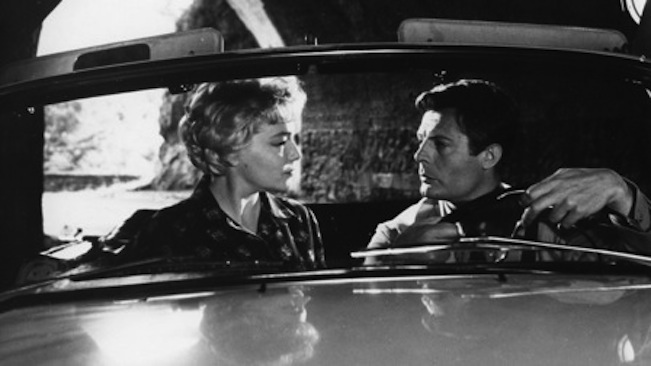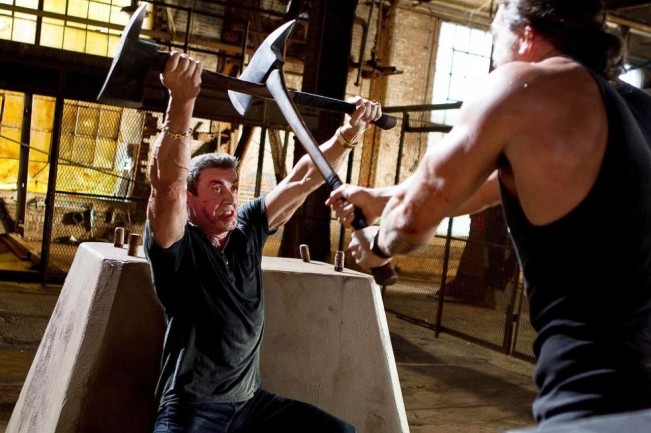

By Mike Wilmington Wilmington@moviecitynews.com
Wilmington on DVDs: The File on Thelma Jordon; Adua and her Friends; Bullet to the Head
THE FILE ON THELMA JORDON (DVD) (Three Stars)
U. S. Robert Siodmak, 1950 (Olive)
Barbara Stanwyck, one of the smartest and toughest of all the classic Hollywood femme fatales, was terrific at playing earthy babes who knew their way around a bedroom—and sometimes a courtroom or an insurance claims office as well. She made a schnook out of policy-seller Fred MacMurray in Double Indemnity, put Van Heflin and Kirk Douglas through the wringer in The Strange Love of Martha Ivers—and here, as the hard-boiled man-killer Thelma Jordon she gives the business to the seemingly solid and non-malleable Wendell Corey, who, as an assistant District Attorney with a real case on Thelma (two real cases in fact), draws the touchy assignment (depending on your viewpoint), of prosecuting her for the murder of an elderly, very wealthy aunt.. Paul Kelly plays his suspicious buddy, Joan Tetzel his not-suspicious-enough wife. And Barbara, of course is the gal who arouses those suspicions, as well as a lot of good old-fashioned Golden Age Hollywood desire.
Corey, who is often cast as a steadfast bourgeois, sidekick or family guy, doesn’t usually get parts like this ladies’ man and court smart assistant D. A.—though he was a marvelous escaped con psycho in Budd Boetticher’s 1956 budget noir thriller The Killer is Loose. In File, he’s surprisingly effective as a straight arrow guy, who’s tough and savvy but whom Thelma bends and chomps on like a Charleston Chew.
Stanwyck of course eats parts like this (and guys like this) for lunch. She was one Hollywood femme star who was never bashful about playing bad girls, or loose women, or even murderesses, and she knew just the right touch of acid to drop into her milk and honey and whiskey come-ons. Thelma Jordon doesn‘t sport a nasty-girl blonde wig like Stanwyck’s Phyllis Dietrichson in Double Indemnity, but she’s adept at skirting the law, and lawyers. First a seeming scheming opportunist who keeps very bad company, then an adulteress, and finally a woman accused of an awful murder, she’s a real dark side knockout.
The movie’s director is one of the authentic masters of film noir: the great German émigré and expressionist puppetmaster of twisted people and sinister streets, Robert Siodmak (The Killers, Criss Cross, Phantom Lady). Siodmak is visually right in his element here. Working with classy cinematographer George Barnes (Spellbound), he pulls us into an inky cinematic pool of psychological havoc and guilt.
The writer of The File on Thelma Jordon, Ketti Frings, was no stranger to noir either. She wrote it black in 1940s-1950s thrillers like Guest in the House, The Accused and Dark City—and eventually she won a Pulitzer Prize for her stage version of Thomas Wolfe’s novel “Look Homeward Angel.” Here, she shows Thelma spinning her webs, and Corey flying into them, and everything getting darker and deadlier—and damned if Frings and Siodmak and Stanwyck don’t even get some sympathy for Thelma as well. (Maybe she deserves it: I won’t give away the file.)
This is Stanwyck at near her bad-best, Siodmak at his darkest and most Teutonically stylish. No, I don’t know why they spell Jordan (as in Michael) with two “o’s.” But, like Wendell Corey, I won’t argue with the lady, especially when the lights go down.
ADUA AND HER FRIENDS (Adua e le Compagne) (DVD) (Three and a Half Stars)
Italy: Antonio Pietrangeli, 1960 (Raro Video)
Adua and her Friends is a treat I didn’t expect, a pleasure that almost seemed to come out of nowhere. It’s a prize-winning 1960 Italian film drama (with a touch of comedy) about a group of Roman prostitutes who are dispossessed by the new anti-brothel Merlin Laws, and who try to relocate to the country, using their savings to open a restaurant. Instead, they are frustrated and undermined by the hypocritical mores and secret corruption of their new customers and patrons—and they wind up being forced to open another bordello by the lawyer who is their secret backer. The film has a superb cast headed by the great earthy French actress Simone Signoret as Adua, the group‘s leader, and Marcello Mastroianni as Pier a local dealer-hustler who woos her, plus Sandra Milo (of 8 ½), Gina Rovere and Emmanuelle Riva (of Hiroshima mon Amour as Lolita, Milly and Marilina, the other three Roman girls, and Claudio Gora as Ercoli, the villainous entrepreneur who begins exploiting them and driving them into prostitution all over again.
The movie was directed by the highly admired Italian cineaste, Antonio Pietrangeli, and written by a crack team that included Pietrangeli, Ettore Scola, Tullio Pinelli and Ruggero Maccari. All the technical credits are first rate, and the film, shot by Armando Nannuzzi, has that special look—glossy-dreamy or rawly realistic—of the black-and-white Italian classics of the late 1950s and early 1960s, films like La Dolce Vita and Visconti’s Rocco and his Brothers. Adua is both serious and entertaining and it works on almost every level. It looks like a classic, feels like a classic, resonates like a classic. So why is it relatively unknown in the U.S.? You got me.
We think we know the cream of the foreign-language films of the twentieth century, but in reality only a handful of films mostly by the best-known directors, like Bergman, Truffaut and Kurosawa reached American theaters. There is a particular wealth if Italian films in the 1960s—both the serious and ambitious artistic works of Fellini, Antonioni and Pasolini, but the genre classics of a Sergio Leone or a Mario Bava that seem even more impressive today. Adua and Her Friends is a film most of you almost certainly have missed, by an excellent director you may never have heard of, despite his high reputation in Europe, and his stature as an important neo-realist and later specialist in left-wing social themes.
Pietrangeli died too soon (1919-1968), and we know too little of his work. This film though should be better known. It features two great European film actors, Signoret and Mastroianni, at the peak of their stardom and talent, with a wonderful ensemble behind them. And it shows us that, in the Italian cinema, and in other foreign language cinema, there is still a lot more for us to find and enjoy. Adua and Her Friends glides deftly between neo-realism and romance, politics and comedy, laughter and sadness. It’s an unknown gem—at least here in America—and a discovery well worth making.
Extras: Introduction by film historian Maurizio Poro; Pietrangeli’s episode from the film Amori di Mezzio Secolo (titled Girandoli 1910); Pietrangeli’s biography and filmography; Booklet with critiques of Adua and her Friends.
BULLET TO THE HEAD (Two and a Half Stars)
U. S. : Walter Hill, 2013 (Warner Brothers)
Sly Stallone is 66, and he has neck and ribcage injuries sustained while working, slugging it out with Stone Cold Steve Austin and Dolph Lundgren on 2010’s The Expendables—and he probably shouldn’t be swinging an axe in a movie axe-fight with another axe-wielding actor (Jason “Conan” Momoa) about half his age, in the new Walter Hill-directed movie Bullet to the Head. But Stallone veered his career away from Oscar-winning sentiment (the first Rocky) to pec-flexing action (the later Rockys and Rambos) decades ago, and he knows, by now, that what he’s doing in movies like this is a little silly. So he also knows how to stand outside the action and make fun of it.
He can use the half-absurd scenes from Matz and Colin Wilson’s graphic novel “Du Plomb dans la tete,” about so-called New Orleans crime—with Stallone as sardonic hit man James “Jimmy Bobo” Bonomo, and Fast and Furious co-star Sung Kang as full-of-himself Korean cop Taylor Kwan —as a springboard for a string of zingers and wisecracks. It’s a mild surprise, though it shouldn‘t be, that Stallone is funny in this movie, which he doesn’t take too seriously. His relaxed self-kidding way with his lines may be the result of coming off some slightly absurd projects: such as surrounding himself with that neck-breaking all-star old-guys crew in the Expendables movies.
Walter Hill and Stallone never made a movie together in the 1980s—and maybe they were right to wait. Bullet to the Head is one of the most entertaining things either of them has done in years. Hill is 71 himself, and he gets into the old guys vs. younger guys mood right away, staging a hit undertaken by Jimmy and his ex-cop partner Louis Blanchard (Jon Seda) of a particularly obnoxious business guy (who has a hooker in his hotel shower). Jimmy and Louis are two been-there guys who whack that sadistic business dude in the middle of his liaison with the whore, a witness whom Jimmy imprudently leaves alive. Pretty soon the hard-boiled killer Keegan (Momoa) has shown up in a hot bar to whack Louie, and to start the bloody ball rolling.
No point in describing any more, because you’ve seen it all before—and what makes a movie like this work is not originality (unless you think axe-fights are a wildly imaginative innovation), but energy and personality and the right kind of smart-assery. Stallone, using his huge bass voice and his big dark, somewhat McCartneyeque eyes, supplies all the personality the movie needs. (Kang though, doesn’t.)
The movie also boasts some evil suits (Christian Slater and Adewale Akinnuote-Agbaje), a lady tattoo artist (Jimmy’s daughter Lisa, played by Sarah Shahi), exploding hideouts and a massacre or two. And guns, of course. And gun killings. It’s the kind of disreputable show that some audiences like precisely because it’s disreputable, and because it’s amusing sometimes to see a little swagger in your movie heroes or anti-heroes.
I’ve always preferred 1970s action and crime movies (in the heyday of Clint Eastwood, Burt Reynolds and Charley Bronson), to the 1980s ones (the heyday of Eastwood, Stallone and Schwarzenegger), because, by comparison, the 1980s actioners (except some of Clint’s and the first Terminator) were so fantasized and empty of real personality, compared to the best 1970s stuff—which would include Hill’s 1975 Hard Times, with Bronson and James Coburn. But at least screenwriter Alessandro Camon (who wrote the excellent military drama The Messenger, in collaboration with writer-director Oren Moverman) gave Stallone some good lines. That’s often all some modern action movies need, and don’t have. Stallone could use a few more scripts with funny dialogue, and fewer opportunities for guys like Stone Cold Steve Austin to give him a hairline fracture or for critics to give him a compressed ego. After all, it’s Sly’s neck.
Extras: None

















I must obtain the film: Adua and her Friends. Can I purchase it on line?